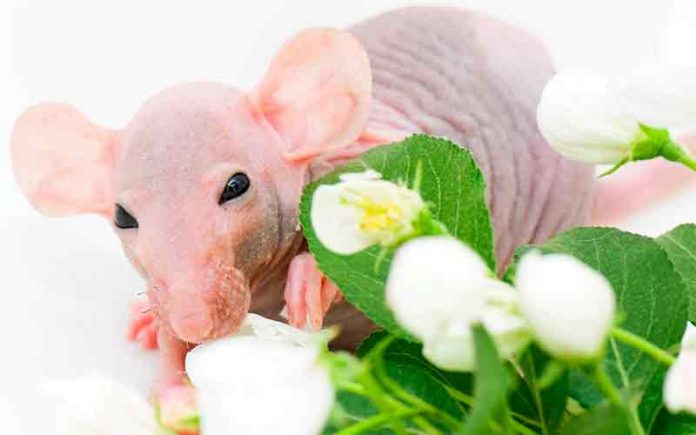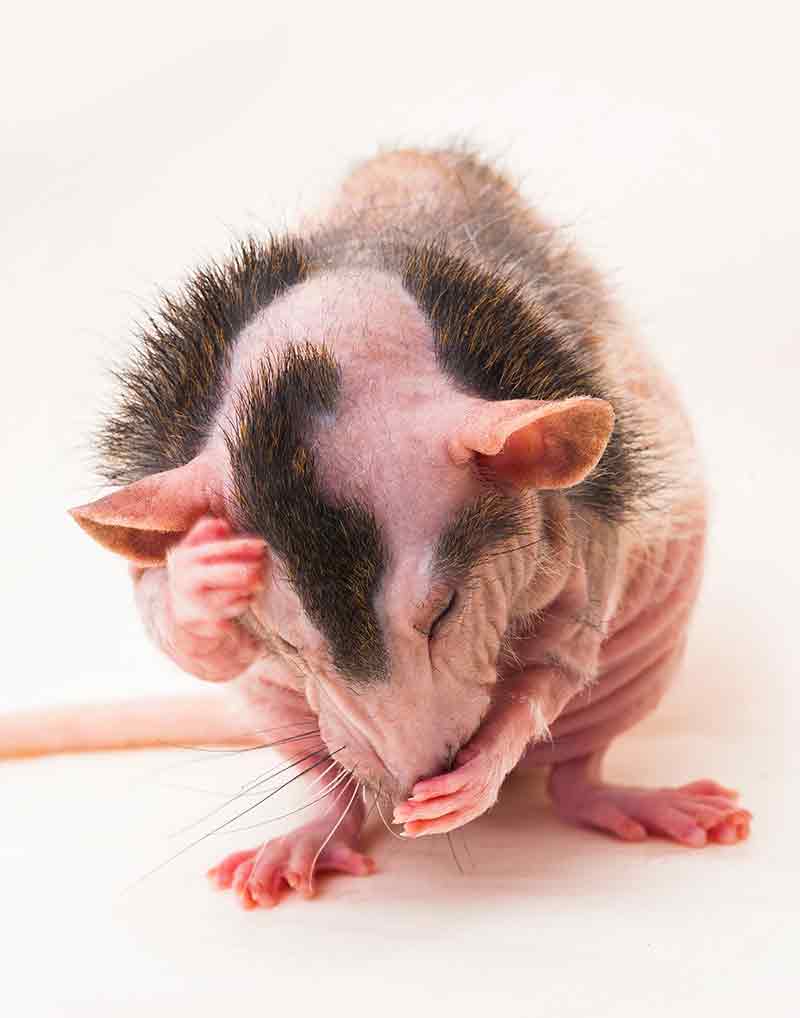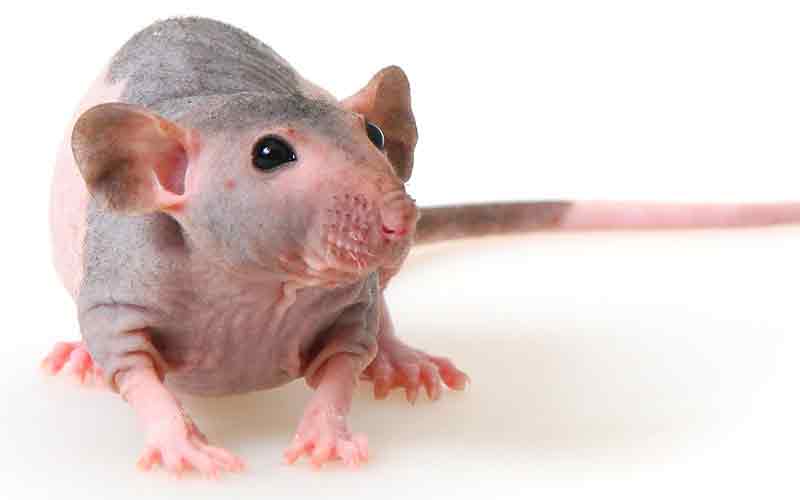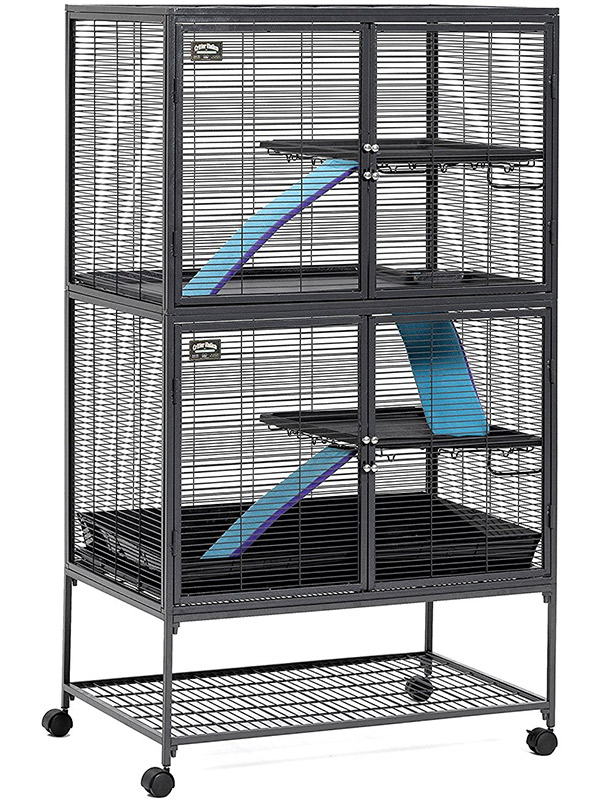Have you ever thought about getting a hairless rat as a pet? If so, then you’re in the right place! Welcome to your complete guide to the hairless rat, sometimes referred to as the “bald rat,” “nude rat,” or the “Sphynx rat”!
Hairless rats are unique animals that require essentially the same care as their haired counterparts.
But with a few extra steps to ensure that they stay warm and that their sensitive skin stays healthy.
However they have some worrying health issues that you will need to consider before you decide to buy one.
In this article, we’ll address everything you’ve ever wanted to know about hairless pet rats.
Including why hairless rats are hairless. Looking at special considerations for hairless rat care and whether or not a hairless rat would be a good pet for you.
What is a hairless rat?
A hairless rat is just what it sounds like – a rat without fur!
Hairless rats are basically a variation of the fancy rat (e.g., a hairless dumbo rat or a hairless rex rat).
They are easily identified by their pink and smooth skin, but otherwise normal rat appearance.
Albino hairless rats have red eyes, but the majority of hairless rats have “normal” black eyes.
Black hairless rats aren’t true hairless rats, as rat skin does not contain pigment. So any perceived coloring is probably just very short dark hair.
And this means that the rat is not a truly hairless rat, but most likely a homozygous Rex rat who is exhibiting only partial hair loss.
Check out the American Fancy Rat Association’s description of homozygous Rex a.k.a. “Patwork” rats here!
So now that we know what hairless rats are, let’s talk about why they are hairless.
Why are hairless rats hairless?
According to the Journal of Investigative Dermatology, hairless rats the result of a genetic mutation that prevents the thymus gland from developing.
The lack of thymus gland causes hairless rats to be severely immune-deficient.
Per the Laboratory Animal Science Journal, hairless rats are born haired, but due to their compromised immune system, their birth hair will completely fall out within a few weeks or months.
The offspring of hairless rats may either become hairless or stay haired, depending on whether or not the hairless parent was bred with another hairless rat or a haired rat.
If one parent is haired, their genes may recess the hairless gene, and so the babies could be born with their thymus glands intact.
Let’s talk about how caring for a hairless rat differs from a haired rat!
Hairless rats as pets
You may already be familiar with caring for a pet rat, but caring for hairless rats requires a bit more know-how.
Refer to the following hairless rat facts for our recommendations on keeping a hairless rat happy and healthy:
Cages for hairless rats
Like other rats, hairless rats required a cage that’s at least one foot tall and two feet wide, without a wire bottom.
Regardless of the type of rat that you purchase, please house them in a cage with no sharp edges or sharp objects. This is important for hairless rats, especially, what with their lack of protection from all things pointy!
Additionally, you’ll need to ensure that your hairless rat’s cage stays warm.
Haired rats are already susceptible to cold, so hairless rats are especially intolerant of cold temperatures.
According to the Merck Veterinary Manual, rats thrive in temperatures of 64-79 degrees Fahrenheit, so hairless rats may be more comfortable in slightly warmer conditions than their haired friends.
Therefore, it may be best to keep a hairless rat in a converted aquariam – the solid walls will ensure that he doesn’t catch a cold draft! However, it can be very hard (and expensive!) to find an aquarium large enough.
Alternatively a giant cage kept in a warm room in your home should suffice as long as he has lots of bedding.
This one on Amazon is perfect for two or three rats to live in.(paid link)
Hairless rat bedding
While rats generally enjoy bedding that’s made of strips of paper, you’ll need to be extra careful about what you bed a hairless rat’s cage with.
This is so because hairless rats do not have hair to protect their delicate skin, so some types of bedding may be drying or otherwise irritating to their skin.
Try to use something soft and absorbent. Check your rat’s skin frequently and experiment as needed.
Additionally, you’ll need to be extra diligent about keeping a hairless rat’s cage clean, since urine and feces can scald their skin if they’re nesting in soiled bedding.
If you have rat hammocks and other rat toys, you will need to rotate and wash them at least every other day.
Hairless rat food
Hairless rats eat the same food as other types of rats.
And, as with any other rat breed, a cute hairless rat can quickly become a fat hairless rat if he’s fed too much.
Reserve the rich foods and treats for special occasions or for training purposes.
Hairless baby rat care
If you have a female hairless rat that you plan to breed or who has had an accidental tryst with a male friend, then you’ll want to pay special attention to this section!
To be brutally honest, breeding hairless rats can take you down a bit of a rocky road.
Female hairless rats typically aren’t the best parents. They have been known to eat their young or to refuse to care for them…yikes!
According to a 1984 study, it’s common for bald female rats to fail at lactation. If they do lactate, then they generally do not produce enough milk to sustain their babies.
This is due to their subpar immune system – they are barely able to sustain themselves, let alone others!
If you end up with a litter of baby hairless rats, they may require bottle feeding with milk replacement formula for a few weeks (and careful observation to ensure that Mom doesn’t do something that she shouldn’t).
If you’re unable to attend to baby mice around the clock, as many of us aren’t, then you may consider keeping a haired mama rat around who could adopt and nurse the babies, should their hairless mother indeed be unable to care for them.
Other than that, hairless rat babies just require the same general care that their haired friends do.
Additionally, all rat babies need extra warmth, so it may be in your hairless babies’ best interest to give them extra baby blankies, bedding, hairless rat sweaters, and/or furry baby friends to snuggle up with.
Pet hairless rat health issues
As we mentioned earlier, since hairless rats aren’t protected by a nice layer of fur, you’ll need to ensure that the temperature where their cage is stays nice and warm (but not too warm), as they get cold quite easily.
Another disadvantage of hairless rats having no hair is the lack of a barrier between their sensitive skin and their surroundings.
This makes them especially prone to getting cuts and scratches, even from things like textured bedding, which wouldn’t normally irritate rats’ skin.
So, you’ll need to bed a hairless rat’s cage with very soft, preferably non-textured bedding.
Also, just because hairless rats don’t have visible hair, doesn’t mean that they don’t have hair follicles!
Their hair essentially breaks off from the follicle when they are babies, but sometimes, the remaining follicle plug can get clogged, creating a pimple-like bump.
These bumps can rupture and become infected, which, for a hairless rat, can become a life or death situation.
Due to their lack of a thymus and subsequent suppressed immune system, hairless rats can get sick or contract bacterial infections pretty easily. If you bring a lot of rats into and out of your colony, it’s likely that your hairless fur babies will fall ill before the others.
You should really disinfect your hands before playing with any rat, but this is especially important if you own hairless rats!
Hairless rat lifespan
So, how long do hairless rats live?
Unfortunately, not very long.
According to the American Fancy Rat and Mouse Association, hairless rats rarely live beyond a year, thanks to their inability or decreased ability to fight off infection.
You may be able to extend their life span if you keep them in a near-perfect housing situation.
Hairless rat price
Hairless rats generally cost a bit more than haired rats.
This could possibly be attributed to the added work that it takes to successfully raise hairless babies to adulthood (recall what we said about hairless rat mommies).
You can expect to pay anywhere from $25 to $50 for a hairless from a breeder, perhaps a bit more if the rat comes from highly valued stock and/or if the breeder participates in health testing or any other precautions.
Should I buy hairless rats?
A rat, hairless or not, can make a lovely pet.
After all, what could be cuter than a dumbo hairless rat, with adorably huge ears? And, how fun would it be to come up with hairless rat names? (We can think of Dobby, ET, and Pinky, to name a few.)
However, hairless rats aren’t as low-maintenance as their furry counterparts.
You’d need to keep a hairless rat with at least one other rat, preferably of the haired variety, so that he has someone to snuggle up to in order to keep warm.
A hairless rat can’t live in just any cage. Rather, he should live in a cage with solid walls that will prevent him from feeling a draft.
Bedding for hairless rats may take some trial and error, as their sensitive skin has no barrier from objects that might be just a little too pointy (such as textured or wood bedding). You’ll definitely want to aim for something soft and extra cushiony.
Keeping a hairless rat’s cage clean would be something that you couldn’t take lightly (not that you should for any other type of rat), as their sensitive skin can actually get scalded if they burrow in feces- and urine-soaked bedding for too long.
Furthermore, hairless rats tend to have compromised immune systems that make breeding and generally keeping them around for very long a bit of a challenge, so you won’t want to become too attached to one.
You’ll need to be prepared for a bit of a challenge to keep your new friend nourished, warm, and healthy!
And ultimately, only you can decide how you feel about buying a pet that is bred to be less healthy than his furred counterparts.
References
Asakawa, M., Yoshioka, T., Matsutani, T., Hikita, I., Suzuki, M., Oshima, I., Tsukahara, K., Arimura, A., Horikawa, T., Hirasawa, T., Sakata, T. “Association of a Mutation in TRPV3 with Defective Hair Growth in Rodents,” Journal of Investigative Dermatology, 2006.
Booth, C. “Mouse with Cuts on Back; Bumps on Hairless Rat’s Stomach” American Fancy Rat and Mouse Association,
Inazu, M., Kasai, K., Sakaquchi, T. “Characteristics of a new hairless mutation (bald) in rats,” Laboratory Animal Science, 1984.




















Rats should NEVER live in an aquarium. They require a cage with adequate ventilation to protect their delicate respiratory systems from ammonia buildup caused by their urine.
you are so correct
I have a bald rat he lives in a Rubbermaid tub with plenty of holes in the top. He has lived in this since he was born and done wonderful. He is 3 years old now. I change out his bedding often and he has never been sick.
My Schmegl is going on 1 year and 3 months and has had no medical issues. She lives in a normal cage with 3 levels and ladders. She has a small cage like bed where she sleeps when it’s warm, and sleeps inside her hammock when cold. Have never had any scratches or skin damage. I hope she will have a decent lifespan.
What would cause my hairless Rat to breath do fast what can ido
I own 4 hairless rats that are well over a year I’ve had them for 16 months and they were full grown when I adopted them. One of them is prone to eye infections but the other 3 are perfectly healthy.
My hairless keeps getting some sort of boil under her eye. The first time it got extremely swollen and when it eventually popped there was a lot of blood. After that, it just comes and goes. And in her other eye it gets a little infected looking. Both of those issues come and go and we have an ointment that we got from the vet to put on her eyes when they’re acting up.
I’m interested in to off your bold rats I have four little chiwawas my self